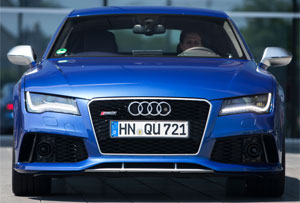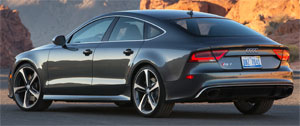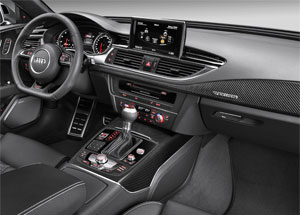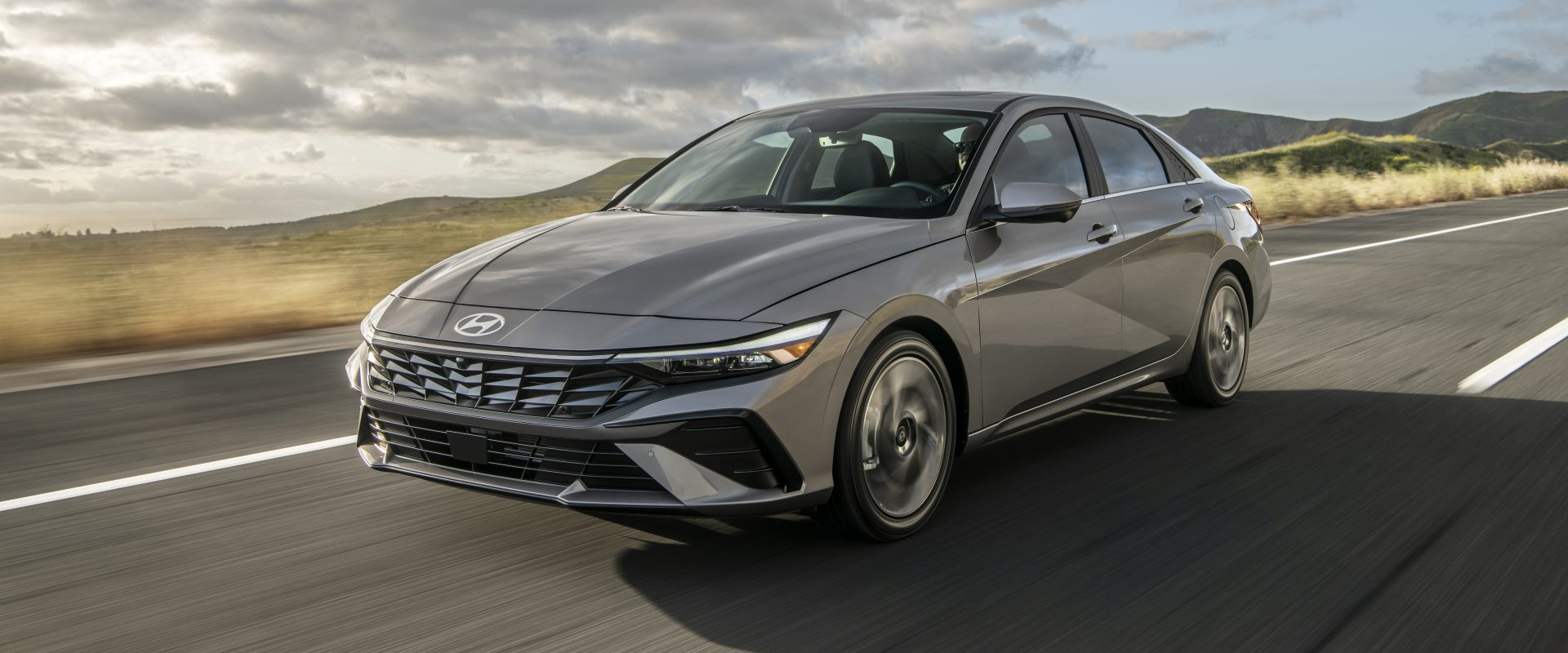2014 Audi RS7
In the rarified world of ultra-high performance Audis, many think the exotic R8 is the champ. But it’s actually the 5-door RS 7 that is the most powerful Audi sold here. That’s right…you don’t need supercar style or impracticality for serious, street-fighting, track melting capabilities. Too good to be true? Well, buckle up!
It took us no time at all to absolutely fall in love with the Audi RS 5 when we hit the track with it last year. But to be honest, that car pales in comparison to this car, the 2014 Audi RS 7.
Building on the far from pedestrian S7, Audi pumps up the performance in just about every area of this vehicle.
Weight has been shaved by 30-pounds. And there’s more power, thanks to Audi cranking up the boost in the twin-turbo 4.0-liter V8 to 17.4 psi. That makes for 560-horsepower and 516 lb-ft. of torque. Quattro all-wheel-drive, along with the S7’s sport differential, and air suspension, are all standard.
 One thing that hasn’t changed, is that much like the S7, this car seems up for just about anything you can throw at it; feeling smooth and steady no matter the speed. Compared to the impressive S7, it cuts through the cones even more effortlessly. Dynamic driving mode keeps the body roll well under control, but doesn’t necessarily make it feel more responsive.
One thing that hasn’t changed, is that much like the S7, this car seems up for just about anything you can throw at it; feeling smooth and steady no matter the speed. Compared to the impressive S7, it cuts through the cones even more effortlessly. Dynamic driving mode keeps the body roll well under control, but doesn’t necessarily make it feel more responsive.
However, the electromechanical steering is insanely quick on turn-in with a precise, heavy weight, but unsurprisingly little feel. More would be hugely welcomed. The upgraded brakes are great for such a heavy car, but not quite in supercar territory with average stops of 117 feet from 60.
Acceleration, however, is glorious, as there is a ridiculous amount of torque and quattro traction propelling you on an 11.7-second adrenaline rush through the quarter-mile at 123 miles-per-hour. The transmission is a straight-up 8-speed Tiptronic automatic, not a DSG, but it works better than most dual clutch boxes, so we have no complaints.
The first two gears seem ultra-low…that’s for acceleration, getting you to 60 in just 3.6-seconds while the top gears go into extreme overdrive. Manual shifting is hard to get just right on the power sweet spots, so just let the computers and accelerometers do their thing and propel you to glory.
 Now if you’re on the highway and you choose to nail the throttle to its fullest, make sure you’re not even close to someone’s bumper, or you’ll be in it in no time as this thing just flat take off. So, it’s quicker than a BMW M6 Gran Coupe, but not quite as fast as the Mercedes-Benz CLS63 AMG. But perhaps more importantly, thanks to cylinder deactivation among other things, it out fuel misers both of them.
Now if you’re on the highway and you choose to nail the throttle to its fullest, make sure you’re not even close to someone’s bumper, or you’ll be in it in no time as this thing just flat take off. So, it’s quicker than a BMW M6 Gran Coupe, but not quite as fast as the Mercedes-Benz CLS63 AMG. But perhaps more importantly, thanks to cylinder deactivation among other things, it out fuel misers both of them.
Government Fuel Economy Ratings are 16-City, 27-Highway, and 19-Combined. So, our average of 22.1 miles-per-gallon of Premium is quite good for supercar-like performance.
This vehicle is clearly made for eating up mass quantities of Autobahn miles at thrilling speeds in extreme serenity, as Audi seems to be in competition with themselves on building the most amazing interiors. No one else is really even in the game, as here the custom-crafted environment gets even better.
 It looks and feels like those super expensive pieces of custom luggage you see that cost well into 5-figures. RS extras include shifter, steering wheel, carbon-fiber trim, unique door handles, and instrument panel.
It looks and feels like those super expensive pieces of custom luggage you see that cost well into 5-figures. RS extras include shifter, steering wheel, carbon-fiber trim, unique door handles, and instrument panel.
Front seats are just great, very racy feeling yet also luxurious to the hilt. While it doesn’t feel, or look particularly big, ease into the rear seats and the car feels huge.
Instead of a one size fits all approach to the exterior design, buyers can opt for standard, matte aluminum, or carbon styling. This example sports the matte aluminum look along with new bumpers, revised Singleframe grille, adaptive rear spoiler, lower diffuser, and big elliptical taillight tips for the highly recommended optional sport exhaust system. Full LED lighting is standard.
But let’s be honest. At $105,795, the $25,000 price leap over an S7 may purely be for bragging rights. Most owners will never experience the full potential of this car. We really don’t have the appropriate roads in North America to fully exploit the RS 7’s capabilities. You do need the German Autobahn, or at least, your own track day for that.
We thought the S7 was terrific. But in creating the 2014 RS 7, the otherworldly Audi engineers are again on point. Too good to be true? Not hardly. Overkill? You’re darn right!
Specifications
- Engine: 4.0-liter V8
- Horsepower: 560
- Torque: 516 lb-ft.
- 0-60 mph: 3.6 seconds
- 1/4 mile: 11.7 seconds @ 123 mph
- EPA: 16 mpg city/ 27 mpg highway
2024 Hyundai Elantra
Basic Transportation At Its Best…And That Is A Compliment
For those of you who write in every week bemoaning the fact that all we seem to do around here is test incredibly expensive cars and EVs that only the very well to do can afford, this one’s for you. It’s a commuter and budget friendly mainstay from Hyundai, the compact Elantra sedan. And, it has been nicely updated for 2024.
We clearly do enjoy driving high-performance machines and ultra-luxury rides around here, but like most of you, when it comes time to drive home at the end of a long workday, we do so in something much more practical and affordable, like this 2024 Hyundai Elantra sedan.
If you’re thinking the front end has gotten more aggressive, you’re right. Hyundai calls it a “Shark Nose” theme, and we’re guessing they were thinking more Great White than Hammerhead, though Megamouth shark would also apply. It helps for a low and wide look; more substantial than the typical compact. Other additions for ’24 include slimmer daytime running lights, revised stainless steel Hyundai emblem, reshaped front fenders, sport sedan-style rear diffuser with silver trim; a parametric pattern added to the C-Pillar, and new LED taillights that take up a lot more space on the highly sculpted decklid. Plus, new wheel designs in sizes ranging from 15- to 18-inches.
Standard engine in SE, SEL, and Limited grades is this naturally aspirated 2.0-liter I4 with 147 horsepower and 132 lb-ft of torque. Even with no hybrid assistance, it gets substantial Government Fuel Economy Ratings of 31 City, 40 Highway, and 34 Combined; we averaged a great 38.6 mpg of Regular.
Those high fuel economy numbers mean acceleration times are pretty high as well. It was in no particular hurry to get off the line at our test track, as after a slight jolt of power, it felt pretty sluggish going down the track, taking us a lengthy 9.4 seconds to hit 60 mph. Hyundai’s Intelligent Variable Transmission has some realistic simulated gear shifts built in, and they not only provided the feel of a true automatic, but kept engine noise from becoming overbearing. And while this 2.0-liter may not be a house-on-fire off the line, it has no problem keeping up with traffic, and feels like just the perfect amount of power for a practical and safe commuter car.
There are other engine options too. Two choices if you want to go faster, a 1.6-liter turbo with 201 horsepower in the Elantra N Line, and a 276-horsepower turbocharged 2.0-liter for the Elantra N; plus, one with even better fuel economy, a 1.6-liter hybrid with a 139 horsepower total output.
And despite some significant understeer, there was good feel through the cones of our handling course, both in steering and chassis feedback. We wouldn’t quite call it “point and shoot,” but it responded to inputs fairly quickly, with only moderate body roll. All-in-all, when it comes to performance, it doesn’t claim to bring a whole lot to the table, but does clearly overachieve with what it does bring.
And Hyundai is always overachieving when it comes to packing in features, yet has found a way of keeping things refreshingly simple with a good mix of touchscreen and manual controls. Lots of space too, both up front in the surprisingly wide front buckets, and in the rear bench with ample room for three. Updates for all Elantra interiors include softer materials on the door panels, upgraded instrumentation and additional charging ports, plus a surround view monitor and new H-Tex simulated leather for Limited trim.
Elantra pricing starts with an SE at $22,775, the SEL comes in at $24,725, Limited begins at $28,215, and the sporty N Line starts at $29,615. If you’re interested in the hybrid, base Blue starts at $27,400 with Limited at $30,600.
Some might say there’s not a whole lot that’s earth shaking about the 2024 Hyundai Elantra, but that’s mostly why we like it so much. When it comes to just delivering good, basic transportation with a high dose of unexpected amenities, Hyundai delivers once again.
Specifications
- Engine: 2.0-liter I4
- Horsepower: 147
- 0-60 mph: 9.4 seconds
- 60-0 Braking: 111 ft (avg)
- MW Fuel Economy: 38.6 MPG (Regular)
- Transmission: IVT
- Torque: 132 lb-ft
- 1/4 Mile: N/A (Track Maintenance)
- EPA: 31 City / 40 Highway / 34 Combined







